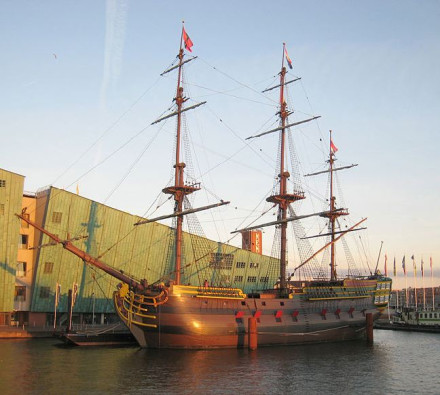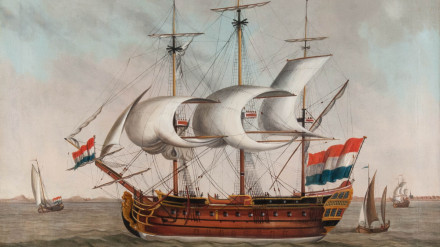History
Loss of the ship and ordeal of the crew
The Amstelveen was a ship of the Dutch East India Company (VOC). She was returning to the Netherlands after making her fifth journey to the East Indies when she ran aground in what is now Oman. Near Cape Madracah, on the evening of 5 August 1763, the Amstelveen was navigating through foggy weather when they struck the sandy beach. Soon after that, the ship capsized due to the large and powerful waves, which then proceeded to break her apart. Out of the crew of 105 men that were on board, only 30 made it to shore.
For the 30 sailors that managed to reach the shore, the ordeal was far from over. Stranded in the desert without a ship, they had to walk for over 500 kilometers in an attempt to reach civilization. 44 days later, they reached a small town with a harbour where they were able to secure passage on a ship to Muscat. A number of the crew died in the desert along the way, as they had no provisions, and even lacked sufficient clothing. Among the men who survived the journey was Cornelis Eyks, the third mate of the Amstelveen. Eyks recorded the journey of the survivors in a logbook and diary, which were published after his return home, sharing the journey of survival these men had undertaken with the rest of the world.
The cargo on her final voyage was:
3760 pounds of nutmeg
11.011 pounds of cloves
5000 pounds of sappanwood
37.000 pounds of tin from Banka
737.268 pounds of sugar (powder)
87.707 pounds of sugar (loafs)

Replica of the Amsterdam, a ship similar to the Amstelveen.
Renewed interest
The 30 surviving crew members, after the death of 75 sailors during the loss of the ship, undertook an arduous trek along the Sharqiyah coast to Muscat. The event, recorded and published in 1766 by the only surviving officer of Amstelveen, Cornelis Eyks, was soon forgotten.
Some of the crew perished in the desert, and in the end, 22 of the original crew of 105 reached Muscat, about six or seven weeks after the loss of the Amstelveen, after walking barefoot with little or no clothes through the dry, empty, and tremendously hot desert in August 1763.
Some years ago, purely by coincidence, an 18th century Dutch logbook was found in an antique bookshop in southern France that turned out to contain Eyks account of the shipwreck. This find renewed interest and attention in Amstelveen, as well as the story of the sailors who survived her wreck and their journey through the desert.
The story of the wreck and subsequent journey on foot is an early example of shared Omani-Dutch heritage. It details the experiences and hardships of Dutch castaways in 18th century Oman, and their encounters with Omani people in the desert.
Oman and the Netherlands share a surprisingly rich mutual maritime heritage, and the story of the Amstelveen has received much attention in this light during meetings of heritage experts from both countries, especially after a Memorandum of Understanding was signed in 2011 to facilitate cooperation regarding the mutual heritage of the Amstelveen, and to research the story of this ship, especially in light of the 250th anniversary of her sinking in 2013. Two research expeditions to the ship with teams made up of both Dutch and Omani researchers were undertaken in 2012 and 2013.
Description
Tonnage: 1150 tons, 500 last
It was the same type as the Geldermalsen, her sister ship.

| Skipper | Nikolaas Pietersz. |
|---|---|
| People on board | 105 |
| Length | 150 feet (45.7 m) |
| Beam | 42 feet (12.8 m) |
Status
The Amstelveen was rumored to have been discovered by divers of Shell working in Oman in the 1990's, but this claim has not been substantiated.
The site was surveyed in 2012 by an international team focused on the shared maritime history of Oman and the Netherlands. Based on these findings, a second expedition was undertaken in 2013 in efforts to find and research the wreck site.
Unfortunately, an already short diving expedition was cut even shorter, from tien days down to four, due to some unexpected problems, and no definitive wreck site was found. The research from both expeditions was still promising, however, and researchers were hopeful that further research in the future could lead to more results. The project was executed in close cooperation with the Ministry of Heritage and Culture of Oman and the Expedition Oman foundation The Dutch public broadcasting agency made this documentary about it.
References
- ANRI marginalia.
Dagregister Kasteel 1764. - Klaas Doornbos (2013).
Shipwreck & survival in Oman 1763.
Pallas Publications. - Cornelis Eyks,Noodlottige gevallen van de Oostindië-vaarder Amstelveen, naar Holland terugkerende vanuit Batavia, in: Tydkorting of magazyn der Heeren; inhoudende een Verzameling van uitgezochte stukken en verhandelingen, aangaande de Natuur- en Zede.